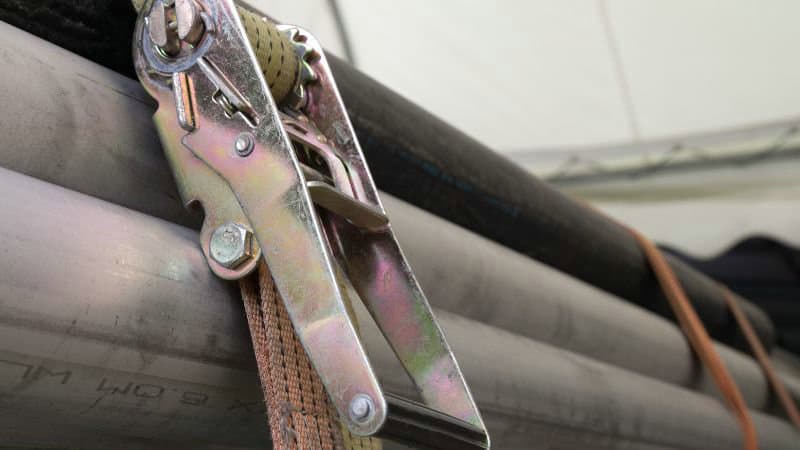
In this comprehensive guide, we will explore the various applications of ratchet straps and provide step-by-step instructions on how to use them effectively. From choosing the right strap for your needs to threading the webbing through the ratchet and securing your cargo, we’ll cover all the essential aspects of using ratchet straps. We’ll also discuss important safety considerations and best practices to ensure that your load remains secure throughout your journey.
Whether you’re new to using ratchet straps or looking to enhance your cargo securement skills, this guide will provide you with the knowledge and confidence to tackle any load-securing task with ease. So, let’s dive in and discover the power and versatility of ratchet straps!
What are Ratchet Straps
Ratchet straps, also known as tie-down straps, are essential tools for securing cargo during transport. These straps are designed to hold your items in place, preventing them from moving or falling off a vehicle.
You can use ratchet straps for a variety of purposes. They come in handy when you need to transport furniture, secure items on a truck bed, or tie down equipment on a trailer.
These straps are easy to use. They typically consist of a long, strong woven material (often polyester) with a ratchet mechanism to tighten the strap. The ratchet allows you to adjust the tension, ensuring your cargo is safely secured.
Key Features of Ratchet Straps:
- Durability: Made from strong materials to handle heavy loads.
- Adjustability: Ratchet mechanism for easy tightening and loosening.
- Versatility: Suitable for different types of cargo and vehicles.
Whether you are hauling household items or securing goods for a long trip, ratchet straps provide a reliable solution. Using them correctly is crucial to ensure your items stay secure during transport.
How to Use a Ratchet Strap

Using ratchet straps properly ensures that your cargo is secure during transport. It involves threading the strap through the ratchet, tightening the strap, securing the cargo, and finally releasing the strap when you’re done.
Threading the Strap
First, open the ratchet handle by pulling up the release lever. This allows you to see the slot at the bottom of the ratchet called the “mandrel.” Take the free end of the strap and thread it through the mandrel from underneath. Pull it through until you have enough length to reach the other end of your cargo.
Make sure the strap lies flat and does not twist. A twisted strap can weaken the tension and might not hold your cargo securely. This step is crucial to avoid slack and ensure the strap will tighten properly.
Tightening the Strap
Once the strap is threaded, you need to remove any slack. Pull the free end of the strap until it is nearly tight. Then, use the ratchet handle to pump the strap tighter. Each pump will create more tension.
Be cautious not to over-tighten. Over-tightening can damage both the cargo and the strap. A good rule of thumb is to check if you can fit a finger between the strap and the cargo. If not, you may need to loosen it slightly. The goal is a secure fit without excessive pressure.
Securing Cargo
After tightening the strap, make sure the cargo is secure. The anchor points to which your strap ends are attached should be strong and stable. These could be D-rings, hooks, or other parts of a truck bed or trailer. Properly securing the closed position ensures the cargo does not shift during transport.
Check that the strap is evenly distributed over the cargo and is not causing any damage. For softer or more delicate items, consider using padding under the strap to protect the cargo from scratches or pressure points.
Releasing the Strap
When it’s time to release the strap, pull and hold the release lever to override the ratcheting mechanism. This allows the ratchet handle to open fully and release the tension. Once the tension is released, pull the strap free from the mandrel.
Make sure the strap is completely free before removing your cargo. Wrap and store your ratchet strap properly to keep it in good condition for the next use. Inspect for any wear or damage, and if you find any, replace the strap to ensure safety.
Ratchet straps make securing cargo simple and efficient, as long as you use them correctly. Proper usage keeps your loads safe on the road.
Different Types of Ratchet Straps and Their Uses

Ratchet straps come in many types, each designed for different needs. They are commonly used to secure cargo, including heavy loads, motorcycles, trucks, vans, and more.
Standard Ratchet Straps
Standard ratchet straps are typically used for securing items like appliances or furniture during a move. They usually feature durable materials such as polyester webbing.
These straps can handle moderate loads and are easy to use with a simple ratcheting mechanism. With lengths ranging from a few feet to several meters, they are suitable for everyday tasks.
Heavy-Duty Ratchet Straps
Heavy-duty ratchet straps are built for the toughest jobs. These straps can handle large loads, often up to 5000 kg. They’re ideal for securing equipment on trucks, trailers, and roof racks.
Made from thick, high-strength webbing, these straps are both strong and reliable. They often come with reinforced hooks and buckles to withstand extreme tension and stress, making them perfect for professional use.
Specialty Ratchet Straps
Specialty ratchet straps are designed for specific tasks, such as securing motorcycles or vehicles. Cam buckle straps use a different mechanism that is gentler on delicate items.
E-track straps are designed to be used with E-track systems in vans and trucks. Wheel nets are used for securing vehicle tires, while tie-down kits offer versatility with multiple attachment points.
Different specialty straps ensure you have the right tool for the job.
Frequently Asked Questions
When is it appropriate to utilize ratchet straps to secure cargo?
Use ratchet straps when transporting heavy items or equipment. They are ideal for moving furniture, motorcycles, and machinery. Ensure the cargo is secured to prevent shifting during transport.
Can ratchet straps be safely employed for lifting purposes?
No, ratchet straps should not be used for lifting. They are designed for securing loads, not hoisting them. Using them for lifting could result in failure and accidents.
What are the techniques for using ratchet straps on a roof rack effectively?
Loop the straps over your cargo and around the crossbars of the roof rack. Attach the hooks and tighten them using the ratchet handle. Ensure the straps lay flat and do not twist to prevent damage to your cargo.
What is the working load limit of ratchet straps?
A working load limit is based on one-third of the breaking strength of the tie downs. The working load limit of ratchet straps increases with the width of the webbing, ranging from around 500 lbs for 1″ straps up to over 5,000 lbs for 4″ heavy duty straps. Always check the WLL tag and never exceed the stated working load limit to ensure safe cargo securement.
